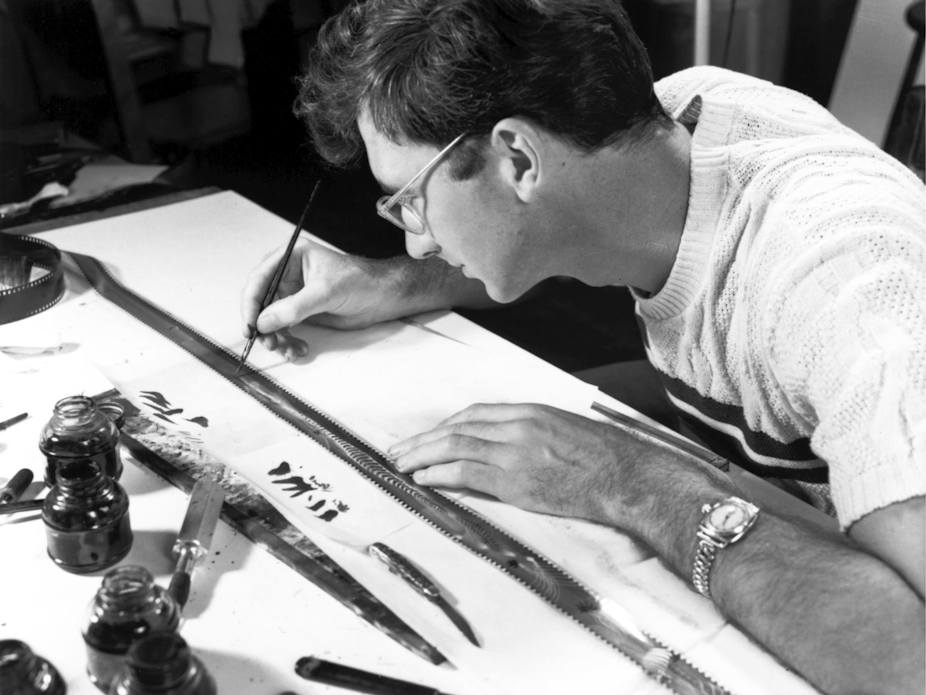Animation is all around us – from Pixar to manga to animated gifs. As with any creative field, it has its unsung heroes – the innovators who have shaped and defined the art form.
So it was a great delight to see one of those innovators, Scottish-born Canadian animator Norman McLaren (1914-1987), recognised at the Melbourne International Animation Festival (MIAF) this month and the breadth of his influence across the globe acknowledged.
Animation is an exhausting business, particularly the way Norman McLaren did it … But some of the obvious problems with McLaren’s process were converted by him into defining assets. Let’s break down some of the innovative techniques McLaren developed which saw him extend the boundaries of creative animation.
To achieve the illusion of movement in animation, the image on each film frame has to be minutely different from its neighbours. The classic Disney animation technique was to photograph differing drawings onto the film stock, using mass-production lines to produce the zillions of required drawings thereby saving on labour, time, and money.
But in the 1930s, McLaren cut through all that – he drew directly onto the film stock, frame by frame. He didn’t need a camera and he could see how his film was going while he was making it.

The film frame is tiny, a mere 16 or 35mm across, and drawing onto such a tiny area meant that the image could only be very simple. This marvellous simplicity and directness was literally magnified when viewed on the big screen.
Slight misregistrations from one image to the next are unavoidable and when the moving image is projected, it trembles. Rather than seeing this as a flaw, this so-called “boiling” gives the image energy, an enhanced liveliness.
McLaren’s hand-drawn method involved an immense amount of drawing. When run through the projector, 24 frames of film only lasted one second. One minute of film required 1,440 frames – and just five minutes needed a staggering 7,200 frames.
McLaren quickly found ingenious shortcuts. Take colour. McLaren drew in black in clear film and had colour added in the processing lab. If a negative was also made and processed in a different colour the overlay of the positive and negative gave two colours.
McLaren discovered when the lab made a botch up – if either the positive or negative was slightly mismatched when overlaid, the moving images acquired white or dark borders. The 1945 animation Hen Hop (below) is a wonderful and colourful example of all this.
Even with his labour-saving methods it could take McLaren more than a year of laborious drawing to make a short film. McLaren’s wears and tears ensured dramatic technical changes with almost every successive film.
Tired of the constant effort to keep his clear film free of dirt, dust and fingerprints (which would be hugely enlarged on the big screen), McLaren decided to draw or scratch on black film. Problem solved. But then he could no longer see where the frames’ boundaries were, making even approximate image registration chancy.
McLaren’s solution was to restrict his drawing to clusters of four or five successive frames leaving blank the stretches of a dozen to 20 frames between the clusters. The resulting film, Blinkity Blank (1955) (below), is a stroboscopic explosion of delight.
In another solution to the problem of drawing frame by laborious frame, McLaren literally ignored the frame divisions – he painted, splashed and dabbed across whole lengths of film. By careful editing, McLaren co-ordinated the visual track to the soundtrack’s musical phrases achieving his wonderfully effervescent film Begone Dull Care (1949).
Occasionally McLaren explored an animation technique that did not involve drawing — stop motion — but instead of moving inanimate objects, he animated people. By photographing his actors frame by frame and moving them slightly between frames, he endowed them with extraordinary abilities, such as self-propelled sliding, gravity-defying leaping and, of course, flying.
The major film using this technique is his powerful, and sometimes disturbing, anti-war parable Neighbours (1952).

As he got older, McLaren turned increasingly to manipulating machines rather than a pen. For his 1968 film Pas de deux he used the optical printer when he repeatedly superimposed delayed image after delayed image of two dancers, the effect being an enhancing of the movement and an enrapturing of the viewer.

Ever the inventive pragmatist, or should that be magician, Norman McLaren could also turn one film into three. In 1960 he made, with Canadian animator Evelyn Lambart, a film in which a vertical line moves laterally and also multiplies, all the while gathering speed to reach a climactic frenzy of lines.

He observed that, perhaps through a subconscious awareness of gravity, horizontal moving lines engender a completely different kinaesthetic response. So, for his next film McLaren simply rotated each frame of Lines Vertical (1960) through 90 degrees (using a prism and an optical printer). He also changed the colours from muted to strident, swapped the calm sounds of Maurice Blackburn’s electronic piano for the dynamic strumming of Pete Seeger’s music, and he had Lines Horizontal (1962).
The best of several stories accounting for the third film’s genesis tells of a private screening of the two Lines films that McLaren was asked to give to a visiting eminent mathematician. A mix-up occurred.
Instead of being screened sequentially, the two films were projected simultaneously so that only the moving intersections of the vertical and horizontal lines were visible. The mathematician swooned. McLaren felt the combination idea worth pursuing. Mosaic (1965) was the triumphant result.

Technology was used by Norman McLaren as a catalyst in his aim to make films of charm, wit, whimsy and sometimes despair, but always to enrich his viewer. His more than 50 films give us cause to celebrate his centenary and, as well, they give us the delightful means to do so.
The Melbourne International Animation Festival (MIAF) continues at the Australian Centre for the Moving Image until June 29.

